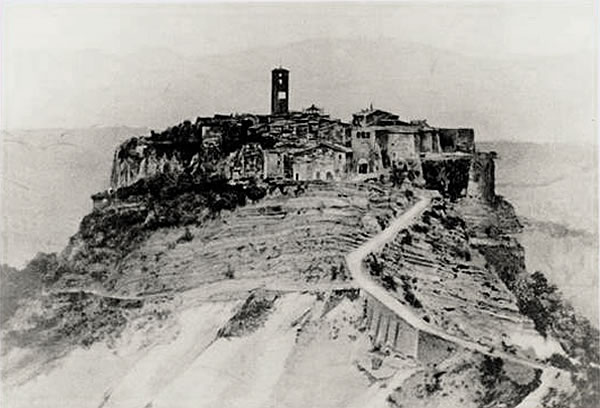Civita di Bagnoregio
The old Civita di Bagnoregio is known as the dying village
because it is placed on high volcanic rock that is based on marine clay banks. The atmospheric agents and the two torrents flowing into the valleys surrounding the village are slowly blowing these banks. Geologists have calculated that the valleys become a 7 centimeters deeper each year.

Civita di Bagnoregio today
The history of territory of Civita di Bagnoregio begins in the Neolithic Age and from then on the site has been frequented with continuity.
The Etruscans founded the city building the acropolis the temples and a forum about 2500 years ago.
The Romans conquered it in the third century B.C. and made the first containment works to save the hill and its habitat. We know very little about what happened during this age, but it is sure that after the fall of the Roman Empire Civita was variously dominated by the Goths and Visigoths and was invaded and sacked for centuries.
In 774, Charlemagne gave the village to the Catholic Church and the papacy administered it with cardinals-governors like Reginald Pole.
During this period Civita reached the pinnacle of its development with the formation of two districts - Ponte (Bridge) and Carcere (Prison) - and the supremacy on the neighbouring village of Bagnoregio (or Balneum Regis. According to legend, this Latin name refers to the particular therapeutic properties of thermal water (no longer existing in this area today) which healed Desire, King of the Lombards.
At the end of the Middle Ages, began the end of the village. In 1348 a plague decimated the population; they started the landslips that drove down the Contrada Carcere in 1450. There was a violent earthquake of magnitude 9-10(Mercalli scale) in 1695 and another in 1703. Landslides and landslips followed till the village let fall into decay in 1826, so people went to live in the nearby Bagnoregio.

Civita di Bagnoregio in 1874
Today the village has more than 800,000 visitors per year but only 10 inhabitants.
The most famous citizen of the ancient village is St. Bonaventura, Franciscan Friar who became Cardinal and taught philosophy at the Sorbonne university. His vocation manifested itself after he was cured by St. Francis in the so-called San Bonaventura's Cave.

Civita di Bagnoregio, Viterbo – San Bonaventura's Cave (it was an Etruscan tomb)

Civita di Bagnoregio, Viterbo: St. Mary Gate (an Etruscan gate bored into tufa)

Civita di Bagnoregio, Viterbo: detail of St. Mary Gate

Civita di Bagnoregio, Viterbo – Bucaione (an Etruscan tunnel bored under the village to quickly reach the valley below)

Civita di Bagnoregio, Viterbo – Church of San Donato built in the 7th century on a pre-existing Roman temple, it overlooks Old Duomo Square that corresponded to the Forum in Roman ages

Civita di Bagnoregio, Viterbo - Anzilotti Palace

Civita di Bagnoregio, Viterbo – Alemanni-Mazzocchi Palace (16th century)

Civita di Bagnoregio, Viterbo – Caves (they were Etruscan tombs)

Civita di Bagnoregio, Viterbo – the dying village

Civita di Bagnoregio, Viterbo – timeline
by M.L. ©ALL RIGHTS RESERVED (Ed 1.0 - 20/11/2017)



